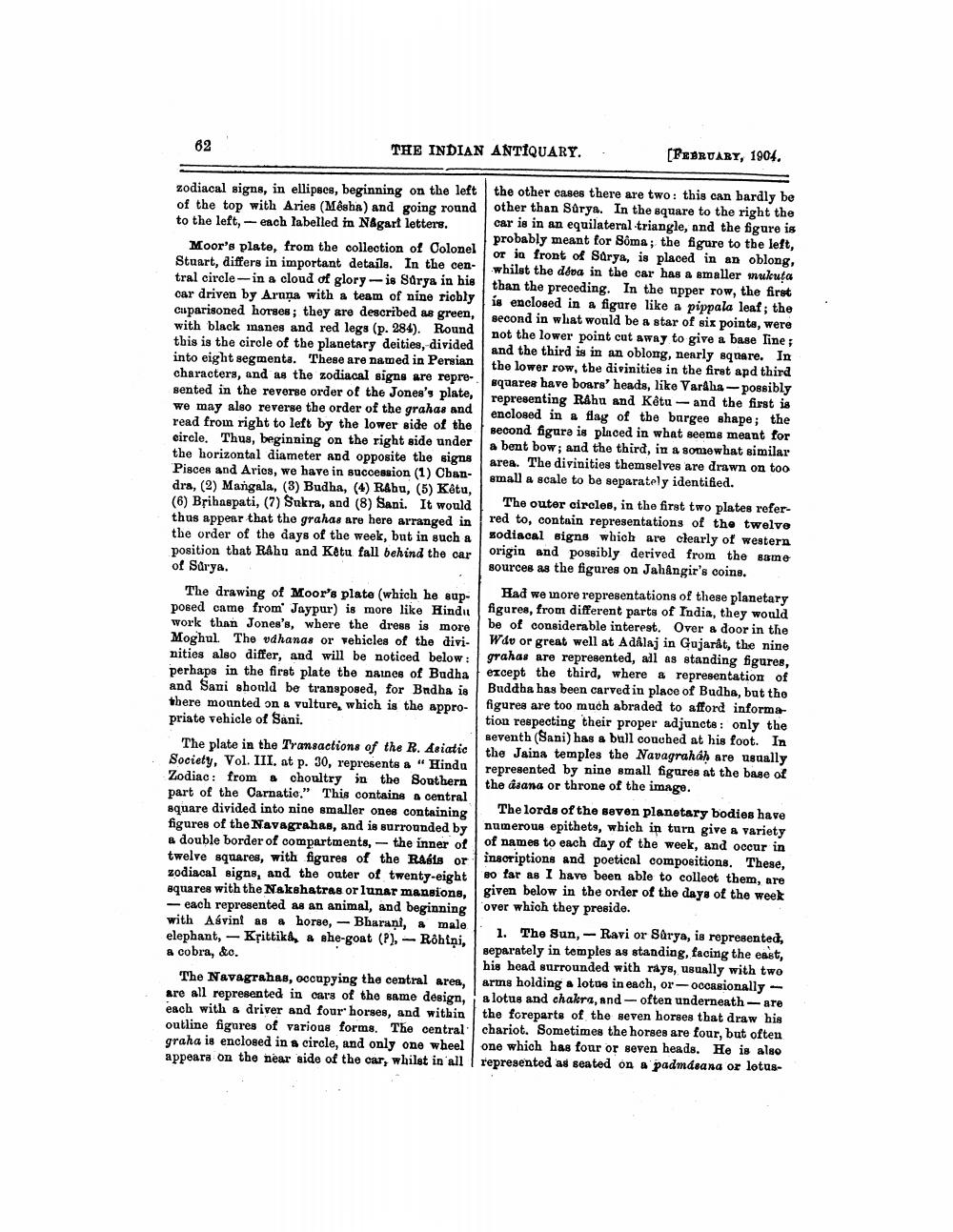________________
82
THE INDIAN ANTIQUARY..
(FEBRUARY, 1904.
zodiacal signs, in ellipses, beginning on the left the other cases there are two: this can bardly be of the top with Aries (Mêsha) and going round other than Surya. In the square to the right the to the left, - each labelled in Någart letters. car is in an equilateral triangle, and the figure is
probably meant for Sôma; the figure to the left, Moor's plate, from the collection of Colonel
or in front of Sarya, is placed in an oblong, Stuart, differs in important details. In the cen
whilst the deva in the car has a smaller ukuta tral circle-in a cloud of glory-is Surya in b18 than the preceding. In the upper row, the first car driven by Aruna with a team of nine ticbly is enclosed in a figure like a pippala leaf; the cuparisoned horses; they are described as green,
second in what would be a star of six pointa, were with black manes and red legs (p. 284). Round
not the lower point cut away to give a base line; this is the circle of the planetary deities, divided
and the third is in an oblong, nearly square. In into eight segments. These are named in Persian
the lower row, the divinities in the first apd third characters, and as the zodiacal signs are repre
squares have boars' heads, like Vardha - possibly sented in the reverse order of the Jones's plate,
representing RAhu and Kêtu- and the first is we may also reverse the order of the grahas and
enclosed in a flag of the burgee shape; the read from right to left by the lower side of the
second figure is placed in what seems meant for circle. Thus, beginning on the right side under
a bent bow; and the third, in a somewhat similar the horizontal diameter and opposite the signs
area. The divinities themselves are drawn on too Pisces and Aries, we have in succession (1) Oban
small a scale to be separately identified. dra, (2) Mangala, (3) Budha, (4) Rabu, (5) Kêtu, (6) Brihaspati, (7) Sukra, and (8) Sani. It would The outer circles, in the first two plates referthus appear that the grahas are here arranged in red to, contain representations of the twelve the order of the days of the week, but in such a xodiacal signs which are clearly of western position that Rabu and Ketu fall behind the car origin and possibly derived from the same of Surya.
sources as the figures on Jahangir's coins. The drawing of Moor's plate (which he eup- Had we more representations of these planetary posed came from Jaypur) is more like Hindu figures, from different parts of India, they would work than Jones's, where the dress is more be of considerable interest. Over a door in the Moghul. The vdhanas or vehicles of the divi. Wdv or great well at Adalaj in Gujarat, the nine nities also differ, and will be noticed below: grahas are represented, all as standing figures, perhaps in the first plate the names of Budha except the third, where & representation of and Sani should be transposed, for Bndha is Buddha has been carved in place of Budha, but the there mounted on a vulture, which is the appro- figures are too much abraded to afford informa priate vehicle of Sani.
tion respecting their proper adjuncte: only the
seventh (Sani) has a ball couched at his foot. In The plate in the Transactions of the R. Asiatic
the Jaina temples the Navagraháh are usually Society, Vol. III. at p. 30, represents a "Hinda
represented by nine small figures at the base of Zodiac: from a choultry in the Southern
the đaana or throne of the image. part of the Carnatio." This contains a central equare divided into nine smaller ones containing
The lords of the seven planetary bodies have figures of the Navagrahas, and is surrounded by
numerous epithets, which in turn give a variety a double border of compartments, the inner of of names to each day of the week, and occur in twelve squares, with figures of the Rasts or insoriptions and poetical compositions. These, zodiacal signs, and the outer of twenty-eight so far as I have been able to collect them, are sanarea with the Nakshatras or lunar mansions. given below in the order of the days of the week - each represented as an animal, and beginning over which they preside. with Asvint as a horse, - Bharani, & male elephant, - Kpittiky a she-goat (P), -Rôhtņi,
1. The Sun, - Ravi or Sarya, is represented, a cobra, &o.
separately in temples as standing, facing the east,
his head surrounded with rays, usually with two The Navagrahas, occupying the central area, arms holding a lotus in each, or- occasionally - are all represented in cars of the same design, a lotus and chakrs, and often underneath - are each with a driver and four horses, and within the foreparts of the seven horses that draw his outline figures of various forms. The central chariot. Sometimes the horses are four, but often graha is enclosed in a circle, and only one wheel one which has four or seven heads. He is also appears on the near side of the car, whilst in all represented as seated on a padmdeana or lotus




